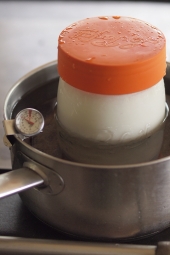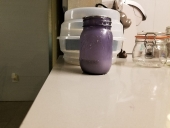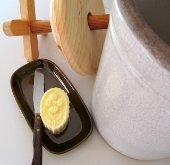
 3
3




![Filename: yoghurtmaker.jpg
Description: [Thumbnail for yoghurtmaker.jpg]](/t/157592/a/135181/yoghurtmaker.jpg)
 6
6




Weeds are just plants with enough surplus will to live to withstand normal levels of gardening!--Alexandra Petri
 4
4




Sourdough Without Fail Natural Small Batch Cheesemaking A Year in an Off-Grid Kitchen Backyard Dairy Goats My website @NourishingPermaculture @KateDownham






 2
2




 2
2













 4
4




Maria Loper wrote:Hi Kate,
I have the backyard dairy goat book and just wanted to confirm something with you. In the yoghurt section where you are talking about making viili, you are using raw milk and not pasteurizing and using the non pasteurized product to make the next batch.
In everything I read online, it seems like it is recommended to pasteurize to make the starter. Are you successful not ever pasteurizing and just propagating forward from the previous batch?
Anyone else have any experience/opinion?
Thanks,
Maria
It is a privilege to live, work and play in the traditional territory of the Salish People.
Now drop and give me 52... ~ Come Join the permies Shoecamp! ~ All about Permies, including Tutorials ---
Twenty bucks off the homesteading bundle for the next 72 hours!
 4
4




Maria Loper wrote:Hi Kate,
I have the backyard dairy goat book and just wanted to confirm something with you. In the yoghurt section where you are talking about making viili, you are using raw milk and not pasteurizing and using the non pasteurized product to make the next batch.
In everything I read online, it seems like it is recommended to pasteurize to make the starter. Are you successful not ever pasteurizing and just propagating forward from the previous batch?
Anyone else have any experience/opinion?
Thanks,
Maria
With appropriate microbes, minerals and organic matter, there is no need for pesticides or herbicides.




"When the whole world is running towards a cliff, he who is running in the opposite direction appears to have lost his mind." C.S. Lewis
Visit https://themaineingredient.com for organic, premium dried culinary herbs that are grown, processed, and packaged in the USA.




Chuck Shaw wrote:I have never tried a yogurt maker but I have tried many many ways of making yogurt. And I have made many many gallons of yogurt. I have used raw milk but it is expensive where I am. But I do use full fat milk always.
You heat the milk to 180 degrees supposedly because it does something to the proteins ( called caseins) allowing them to bind with.... blah, blah blah. And It kills any bad bacteria that may be present in the milk.
The trick is to cool the milk down BEFORE ( very important) adding your culture, to 110 degrees. Once you add the culture it is important to keep the milk in the 110ish degree range. I start my yogurt with 1/4 cup or so of store bought PLAIN yogurt. You can even buy the small cups and just scoop the plain yogurt off the top without getting any of the fruit underneath in it. But you have to look on the container and it has to say " active live culture". Once you add the culture it's a waiting game. The longer you wait the tangier it is. I find eight hours is perfect for me but it will depend on the culturing temperature.
I save the last 1/4 cup to start my next batch. Trust me, I'm no expert so I have no idea if my cultures get weaker after several batches but I figure that if my saved yogurt turns my milk thick like yogurt that there must still be some good bacteria in it. I don't know. Maybe someone smarter than me can answer that one.
At the end of that time you will have a very thin yogurt as it will still have all of the whey in it. This whey can be strained out to your desired yogurt thickness. I use to use a tea towel that I put in a colander over a bowl. But that is a messy pain in the rump. I now use a euro cuisine yogurt strainer I got off Amazon. If you are a home yogurt maker you will love that strainer.
Anyways, After all my years of making yogurt the hands down, easiest, largest quantity at one time yogurt maker is my Ninja Foodi. It has literally changed my yogurt making life. I have the push button model ( not the one with the dial on front) and if I push the "slow cooker" button twice it says "YGRT". It tells you everything you have to do. Boil, Cool, add and stir etc etc. It maintains the perfect temp for the time you set it for. Like I said, 8 hrs is perfect for me. Boil with the lid off. Use the pressure lid with the vent in the "open" position for the long culturing process.
No matter how you make it I recommend you get the Euro strainer and strain the yogurt overnight in your fridge. At that point you will have very thick Greek type yogurt. BUT, you have all of that lovely whey that has dripped to the bottom bowl. Now you can stir that back in , in small amounts, till you get it just the way you like it. And don't throw that whey away. It's good for you. I drink it sometimes. Tangy and refreshing. I feed it (small amt) to houseplants. Put it in your dogs water. There are lots of things you can do with it. Just look online. If I don't use it I dump it on my compost pile.
When its time to eat it I add my homemade granola, maybe some fruit if I have it, honey or REAL maple syrup and a little splash of vanilla flavoring ( not extract). It is sooooo good.
Sometimes I find that mine has little tiny lumps of milk protein (?) that for lack of a better description I call sandy. But it is still amazing. I'm experimenting but I'm thinking that those "sandy" bits are what has stuck to the bottom of the pot and I was scraping them off and back into the milk when I was stirring the culture in. My last batch was very creamy.
I know this may sound complicated but I can assure you it is not.
As a recap:
1- heat milk to 180
2-cool to 110
3- add culture
4- maintain 110 (ish) degrees for your desired culturing time. Remember, the longer you go the tangier it is.
5-strain in fridge overnight
6-Add whey back in to your desired thickness
7-enjoy
8-Remember to save the last 1/4 cup, if you have the willpower, to start your next batch.
Good luck. you won't be sorry you decided to make your own homemade yogurt that YOU control what goes in it !!
Apartment-dwelling hopeful future permie

|
This is awkward. I've grown a second evil head. I'm going to need a machete and a tiny ad ...
The new gardening playing cards kickstarter is now live!
https://www.kickstarter.com/projects/paulwheaton/garden-cards
|






